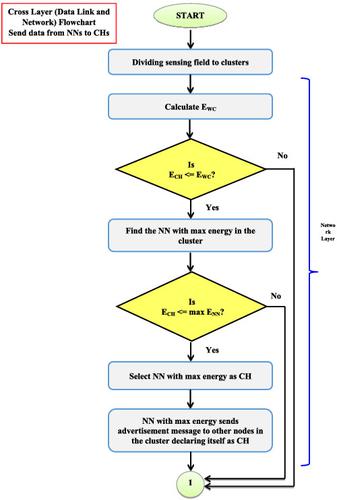当前位置:
X-MOL 学术
›
Int. J. Commun. Syst.
›
论文详情
Our official English website, www.x-mol.net, welcomes your
feedback! (Note: you will need to create a separate account there.)
Designing a reliable and energy-efficient cross-layer protocol for wireless sensor networks
International Journal of Communication Systems ( IF 1.7 ) Pub Date : 2021-06-09 , DOI: 10.1002/dac.4904 Salah Abdulghani Alabady 1 , Sukaina Shukur Alhajji 1
International Journal of Communication Systems ( IF 1.7 ) Pub Date : 2021-06-09 , DOI: 10.1002/dac.4904 Salah Abdulghani Alabady 1 , Sukaina Shukur Alhajji 1
Affiliation

|
Due to the energy scarcity that the wireless sensor networks currently face, many energy-efficient protocols have been developed and proposed in different layers, especially in the data link and network layers, as a large amount of energy consumed by the transceiver, idle-listening, collision, selecting the correct nodes to act as routers, long-distance transmission, etc., which are the responsibility of data link and network layers. Since these protocols address the reasons for energy loss in one layer and neglect the treatment of energy loss in other layers, as each layer of the TCP/IP module has its own features and has no control over the other layers. Therefore, there was a need for a cross-layer design. In this paper, an energy-efficient cross-layer between MAC layer and network layer has been proposed using slotted ALOHA based p-persistent CSMA MAC protocol and Enhance Energy Conservation based on Residual Energy and Distance (EECRED) in order to reduce energy consumption and increase the network lifetime. The performance of the proposed cross-layer protocol is evaluated by simulating the protocol using the MATLAB simulation. The simulation results are compared with the Fuzzy and Ant Colony Optimization (ACO) based MAC/Routing cross-layer protocol (FAMACRO), FAMACRO for wireless sensor networks (FAMACROW), fuzzy cross-layer LEACH, routing-MAC, and Energy-efficient Cross-layer-sensing Clustering Method (ECCM) protocols to ensure the efficiency of the proposed cross-layer. The simulation results show that the proposed cross-layer protocol is very energy efficient, provides stable networks, consumes little energy, and significantly increases the life of the network compared to the single-layer protocols where the improvement rate was 45%, 53%, 37%, 91%, and 28.72% compared to FAMACRO, FAMAROW, fuzzy cross-layer LEACH, routing-MAC, and ECCM protocols respectively in terms of the number of alive nodes or residual energy.
中文翻译:

为无线传感器网络设计可靠且节能的跨层协议
由于无线传感器网络目前面临的能源稀缺性,许多节能协议已经在不同层被开发和提出,特别是在数据链路层和网络层,由于收发器消耗大量能量,空闲监听、碰撞、选择正确的节点作为路由器、远距离传输等,这些都是数据链路层和网络层的职责。由于这些协议解决了一层能量损失的原因,而忽略了对其他层能量损失的处理,因为TCP/IP模块的每一层都有自己的特点,对其他层没有控制权。因此,需要进行跨层设计。在本文中,MAC 层和网络层之间的节能交叉层已经提出使用基于时隙 ALOHA 的 p 持久 CSMA MAC 协议和基于剩余能量和距离的增强节能 (EECRED),以减少能源消耗并增加网络寿命. 通过使用 MATLAB 仿真对协议进行仿真来评估所提出的跨层协议的性能。仿真结果与基于模糊和蚁群优化 (ACO) 的 MAC/路由跨层协议 (FAMACRO)、无线传感器网络的 FAMACRO (FAMACROW)、模糊跨层 LEACH、路由-MAC 和节能跨层感知聚类方法(ECCM)协议,以确保提出的跨层的效率。
更新日期:2021-07-06
中文翻译:

为无线传感器网络设计可靠且节能的跨层协议
由于无线传感器网络目前面临的能源稀缺性,许多节能协议已经在不同层被开发和提出,特别是在数据链路层和网络层,由于收发器消耗大量能量,空闲监听、碰撞、选择正确的节点作为路由器、远距离传输等,这些都是数据链路层和网络层的职责。由于这些协议解决了一层能量损失的原因,而忽略了对其他层能量损失的处理,因为TCP/IP模块的每一层都有自己的特点,对其他层没有控制权。因此,需要进行跨层设计。在本文中,MAC 层和网络层之间的节能交叉层已经提出使用基于时隙 ALOHA 的 p 持久 CSMA MAC 协议和基于剩余能量和距离的增强节能 (EECRED),以减少能源消耗并增加网络寿命. 通过使用 MATLAB 仿真对协议进行仿真来评估所提出的跨层协议的性能。仿真结果与基于模糊和蚁群优化 (ACO) 的 MAC/路由跨层协议 (FAMACRO)、无线传感器网络的 FAMACRO (FAMACROW)、模糊跨层 LEACH、路由-MAC 和节能跨层感知聚类方法(ECCM)协议,以确保提出的跨层的效率。










































 京公网安备 11010802027423号
京公网安备 11010802027423号